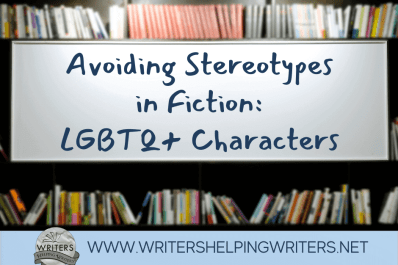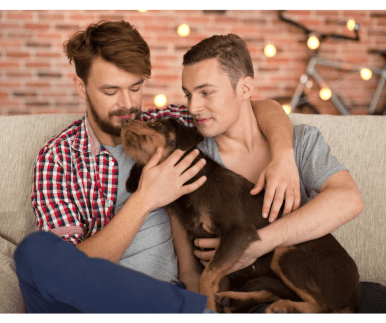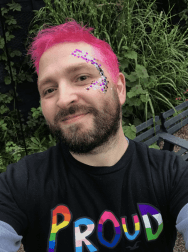Avoiding Stereotypes in Fiction: LGBTQ+ Characters
Readers have spoken: they want more diversity in fiction. And writers are stepping up, but it can be hard to write about someone who���s different than you. Careful research is the key to avoiding misrepresentation, which causes harm to the very identities being portrayed and creates fallout for well-meaning writers when they���re called out by readers.
For this reason, we���re running a series of posts on avoiding stereotypes in fiction. Written by a diverse cast of talented authors, each post highlights a different people group���the common stereotypes to avoid and how to write those characters realistically. We hope this series arms you with the knowledge and tools to write characters you may have been reluctant to write before���ones that will take your story to the next level.

By: Drew Hubbard
When it comes to LGBTQ characters, some people believe that there’s ���too many of them.���
According to a report done by GLAAD on scripted broadcast primetime (American) programming in the 2021-2022 season, 11.9% of characters identified as LGBTQ . Factoring in TV shows (and movies) from across the world, I’d bet money on that % dropping considerably.
Despite the LGBTQ community being extremely diverse in many ways (race, ethnicity, age, ability, neurodiversity, gender identity, etc), we still see the same characters and the same stereotypes over and over again. We’d love to change that. So, to give you somewhere to start (and not overwhelm you), here are the 9 WOOOOORST LGBTQ stereotypes and how to avoid them.
Stereotype #1: THE PREDATORY (OLDER) LESBIANProblem: She’s a lesbian cougar. She has her sights on a younger woman who’s nearly always ���straight��� and ready to be turned. She’s very controlling, often written to pamper to the male gaze, and thus behaves like a straight man. It’s basically yuk on so many levels.
Solution: Allow older lesbian characters to be in happy, secure relationships. Perhaps she has been in one for years/decades. She could also be single and happy. Or, rather than being predatory, let her be looking to find a woman she can connect with, not dominate.
Stereotype #2: THE PROMISCIOUS GAYProblem: All this chap is interested in is sex. A relationship sounds too hetero for him. It’s a dated stereotype from a time when being gay was kept secret. You rarely see two men being romantic together, sharing a life together, being monogamous together.

Solution: Gay (or bi/pan/queer) men can and do hold down long-lasting relationships. Yes, this stereotype does have a lot of truth (no slut-shaming here), however, it’s important to show younger people that being gay doesn’t mean you cannot find love and connection.
Stereotype #3: THE DUPLICITOUS BISEXUALProblem: Bisexuals are attracted to multiple genders, so of course they’re going to be cheaters, what with temptation everywhere. Vom! Pinning them down to one partner looks like they’re choosing a side, so they must assert their bisexuality card, otherwise it will be revoked.
Solution: Bisexual people can be in happy, stable, monogamous relationships. And���spoiler alert���they are still bisexual. You could literally make any character bi, doesn’t matter if they’re in a same-sex or opposite-sex relationship. Plus, you can show a character being attracted to multiple genders without reverting to this cheating stereotype.
Stereotype #4: THE BODY-HATING TRANS PERSONProblem: It’s all sadness, all the time for this poor transgender person. Not wanting to identify as their birth gender can only mean they hate their body immensely. All they can think about is removing parts of their body, there’s literally no time for anything else.
Solution: While some trans people do have gender-affirming surgery, many don’t and are still happy with their body. Still, why have a trans character going through a transition at all? Maybe they’ve already done that. Let their plot point be based on the story, not their trans-ness.
Stereotype #5: THE QUEER ONE AND ONLYProblem: These characters are often quite easy to identify as being written by a cishet writer because they exist alone. They’re the one and only queer amongst all the straights and don’t have any queer community outside of that cishet friendship group because why would they need other queers in their life?
Solution: Queer people find their LGBTQ family in real life, so why not have more than one queer? (Hello, bisexuals!) If you don’t want to write multiple queers, then at least have your queer character talk about their queer friends/family/community so the audience knows they don’t exist in a heterosexual vacuum. Some LGBTQ people might be surrounded by cishet people at work, but it’s not unusual for LGBTQ people to NOT have a single cishet person within their friendship circle. We find people to support and lift us up. Let your characters have that luxury too.
Stereotype #6: THE BROKEN ASEXUALProblem: There’s hardly ever any nuance to asexual characters. Despite asexuality being a spectrum, they’re usually shown as broken humans who have had asexuality forced upon them because of trauma or a medical condition.
Solution: Your ace characters can still have sex���that is not unrealistic. But also they can be confident and happy with their aceness. It doesn’t need to affect their every waking moment; it’s just one thing they don’t want/need, and these characters don’t always need to be thinking/talking about how much they don’t want sex. Simple.
Stereotype #7: THE EMOTIONLESS AROMANTICProblem: Even though being Aromantic means not feeling any (or much) romantic attraction, these characters are portrayed as being so unfeeling that they can’t even stand having friends. They’re often literally written as aliens or robots. How rude!
Solution: Being aromantic simply means having no or little romantic attraction. It doesn’t mean they have zero feelings/emotions at all. Rather than showing an aromantic as feeling like they’re missing out on romance/love, you can show them as being happy and comfortable with their identity.
(It’s worth pointing out that although some people identify as both Asexual and Aromantic, many people identify as just one of those and NOT the other.)
Stereotype #8: THE ANDROGYNOUS NONBINARY PERSONProblem: Being nonbinary means different things to different people, but of course enby characters are often shown as dead-centre between traditionally masculine and feminine. No nuance. No fluidity. Just an androgynous display at all times, from clothes to appearance.
Solution: Nonbinary people don’t need to show they are enby in their clothes and looks (I mean, what is the ���norm��� of any particular gender anyway?). They may also change it up depending on how they feel on a certain day, so rather than an enby person using just they/them pronouns, they might mix it up with other pronouns, too. There’s literally nothing stopping you making any character nonbinary. There’s no ‘one way’ to portray one’s nonbinaryness.
Stereotype #9: THE OVERSEXED PANSEXUALProblem: Pansexuals are attracted to the person, regardless of gender or gender identity, so obviously they are attracted to every single living human being and thus are always looking for the next hookup. Plus, there has to be that one joke about being attracted to pans. YAWN!
Solution: Pansexual people are all about their openness to be attracted to the person, so why not concentrate on that? Focus on the love a pansexual character has to give rather than focusing on their libido, which is very boring and quite insulting.
RESOURCESAs with writing any character that is unlike yourself, your best resource is talking to that community. You can reach out to LGBTQ people on social media to ask for their advice. And there are many online resources you can consult. Here are some good places to start.
Bang2write! has many articles on writing diverse characters. Lucy V. Hay has even written an entire book on the topic.My newsletter, Pride Reads, has monthly tips, advice, and surveys from members of the LGBTQ community discussing what they do and don’t want when it comes to representation.You could also seek out a sensitivity reader. Different from a beta reader, sensitivity readers will concentrate on the potentially problematic aspects of the story, advise you on what could be an issue, and suggest how you could bring more authenticity to the characters.Discussion is encouraged, but please keep it courteous. Let���s not call out authors for past mistakes, and let���s do keep an open mind. By listening to and respecting each person���s experiences and perspectives, we can better write the stories and characters readers want to see.

Drew Hubbard is a screenwriter and soon-to-be-novelist who runs ‘Pride Reads’ – a monthly LGBTQ writing newsletter for all writers who want to create better LGBTQ characters and stories.
He also offers a script feedback service and sensitivity reads. Find him on Twitter or Instagram.
The post Avoiding Stereotypes in Fiction: LGBTQ Characters appeared first on WRITERS HELPING WRITERS��.
Writers Helping Writers
- Angela Ackerman's profile
- 1014 followers



